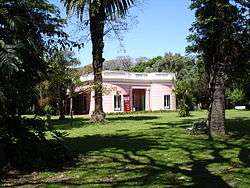Florida, Buenos Aires
| Florida | |
|---|---|
|
Quinta Trabucco, nowadays a cultural centre. | |
 Florida Location in Greater Buenos Aires | |
| Coordinates: 34°31′S 58°30′W / 34.517°S 58.500°WCoordinates: 34°31′S 58°30′W / 34.517°S 58.500°W | |
| Country |
|
| Province |
|
| Partido | Vicente López |
| Founded | 1891 |
| Elevation | 13 m (43 ft) |
| Population (2001 census [INDEC]) | |
| • Total | 59,844 |
| CPA Base | B 1602 |
| Area code(s) | +54 11 |
| Website | lapaginadeflorida |
Florida (officially Florida Este) is a mostly residential barrio of the Vicente López Partido in the northern suburbs of Greater Buenos Aires, Argentina. It is principally a middle-class neighbourhood and is located between the barrios of Olivos and Vicente López, also in the same partido (department).
Location
The city is located between The Autopista Pascual Palazzo (mostly known as "Panamericana" or "Acceso Norte") highway and the Maipú Avenue. The Acceso Norte splits the district into two neighborhoods: Florida Este (from Panamericana to Maipú Avenue) and Florida Oeste (from Panamericana to De los Constituyentes Avenue).
Florida is served by the Mitre Line, which provides easy access to the city of Buenos Aires. Due to the railway lines, Este and Oeste neighborhoods are also called "Florida Mitre" or "Florida Belgrano". Its main commercial area is centered on General San Martín avenue.
History
Florida was founded in 1891 when the Buenos Aires and Rosario Railway opened a station in the section from Belgrano that then reached Bartolomé Mitre, Borges and San Isidro. Some versions state that the station (and subsequently the village) was named "Florida" to commemorate a victory over Spanish army in the Paraje La Florida of Alto Perú on May 25, 1814, during the War of Independence.
The official date of establishment was set by a decree that gave approval to the builder of the railway line to divide tha lands into lots for future sells. The date was set on May 7, 1891. Between 1895 and 1915 the "Compañía de los Ferrocarriles Pobladores" and the French Bank that owned lands in the zone, sold them to families that quickly arrived to the region and settled the area.
The Florida station was a point of reunion among the inhabitants of the districts, with the Luis Poggi's general store (located on the corner of San Martín and Fray Justo Sarmiento) as one of the pioneers in the zone. Most of the residential houses grouped near the station, while the country hoses located in current Melo street. Little farms where vegetables were grown, established near Mitre Avenue.
By Municipal Ordinance, Florida was declared "village", in 1907. Six years after, the bishop of La Plata, Juan Terrero, bless a precarious chapel built in lands previously donated by José Antonio Trabucco. The Rossi family donated an image of Virgin Mary sculpted in Carrara marble in Italy. The first priest of the region was Father José A. Coffa, then succeeded by Father Vanini who started works for a construction of the church. The temple, finished in 1931, was named "Nuestra Señora de la Guardia" being the first church in Florida.[1]
Education
The area once had a German school, Rudolf-Steiner-Schule.[2]
Sports
Florida has many sport clubs, being mostly notable the Club Atlético Platense, established in 1905, which hosts a wide range of sports although it is mostly known for its football team, affiliated to AFA. Platense's home ground is Estadio Ciudad de Vicente López. Other notable clubs of the neighborhood is Sportivo Balcarce that played in Primera División during the 1920s.
Gallery
 San Martín Avenue
San Martín Avenue Parroquia Santa Teresita del Niño Jesús
Parroquia Santa Teresita del Niño Jesús Plaza Héctor González
Plaza Héctor González Belgrano Norte train station.
Belgrano Norte train station. Level crossing on Laprida Avenue.
Level crossing on Laprida Avenue.
References
- ↑ "Breve historia de Florida", Centro Alfonsina Storni
- ↑ "Deutscher Bundestag 4. Wahlperiode Drucksache IV/3672" (Archive). Bundestag (West Germany). 23 June 1965. Retrieved on 12 March 2016. p. 17/51.
External links
| Wikimedia Commons has media related to Florida. |
- Municipal information: Municipal Affairs Federal Institute (IFAM), Municipal Affairs Secretariat, Ministry of Interior, Argentina. (Spanish)
- La Página de Florida
